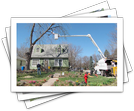Buyers, Get an Edge During The Busy Spring Season
Sponsored By
Getting started early is key to success

The spring and summer months are traditionally the busiest times of year for the residential real estate market. Weather is more cooperative and many families like to move while the kids are on their summer break.
But in recent years spring, for many regions, has meant more homes on the market, but also more buyers, fierce competition and an increase in prices.
If you're in the market for a house this spring, there are a number of steps you can take to try to give you the advantage over other homebuyers, including:
- If you're going to work with a Realtor or real estate professional, get started early. Interview three or four, get references and let the person you choose know exactly what you're looking for.
- Get your loan pre-approved. This will give an advantage on several fronts. First, it will be done and out of the way. Second, you'll know how much the bank is willing to loan you so you know in which price range to look. And third, it shows sellers that you're serious and ready to buy when you make an offer.
- Figure out how much you have for a down payment. NAR says first-time buyers typically make a down payment of 6 percent on a home purchase, and 24 percent of down payment funds were gifts from relatives or friends. If that's not an option, there are many loan programs that accept down payments of five or three percent. And don't forget closing costs, which will often run two to seven percent of the property's purchase price.
- Be ready at a moment's notice. If you're in an especially tight market, your Realtor will be reviewing new listings as soon as they're available. If he or she finds something that matches your criteria, you'll want to look at the house and be ready to make an offer -- quickly.
- When looking at houses, look at the potential. There are major factors you won't be able to change -- the neighborhood, proximity to work and schools, the basic floorplan of the house (unless you plan on completely renovating), and size of the back yard, among other things. If you're put off by paint or carpet color or old linoleum floors, envision what the walls will look like with your color of choice and the floors in a material you prefer.
- If you're buying in a seller's market, listen carefully to your Realtor or agent about how much you should offer. If there's competition you may want to offer more than the listing price and you shouldn't try asking for things like carpet allowances or a long closing date. If you know sellers may have several offers in front of them, you'll want to make yours the best.
- Begin thinking about homeowners' insurance now. Begin by making sure your credit report is accurate -- credit histories are sometimes used to determine whether a company will insure you, and, if so, at what rate. Also, the Insurance Information Institute says you should get a copy of your loss history report, such as a CLUE report from ChoicePoint or an A-PLUS report from Insurance Services Office. This is a record of home insurance claims you have filed. If you have not filed any insurance claims in the past five years, you won't have a loss history report. The better your report, the better chance you'll have of obtaining reasonably-priced insurance on the house you buy. And if you're renting, make sure you have renter's insurance -- it's helpful to have insurance history when you obtain insurance for your new house.











